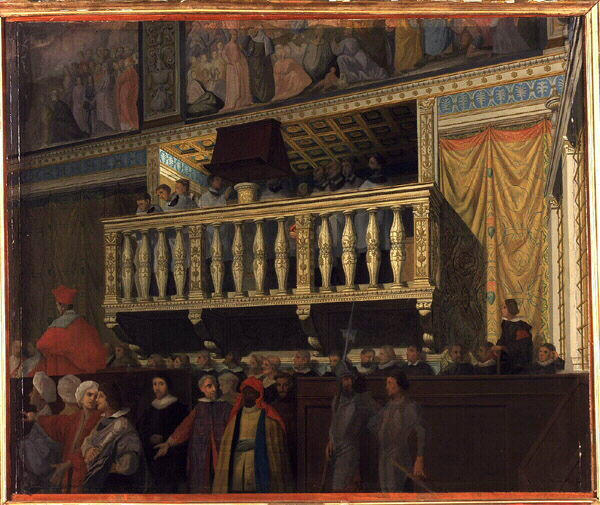Description
The painting "The Choir of the Sistine Chapel", created in 1848 by Jean-Auguste-Dominique Ingres, is a work that reflects the artist's mastery in the representation of space, the human figure and lighting. Ingres, a protagonist of Neoclassicism and known for his precise and detailed style, achieves in this painting a fusion between Renaissance architecture and a romantic interpretation of the subject.
At first glance, what is striking is the balanced composition and the arrangement of the elements within the work. In the centre, we can see a choir of figures who seem to be in the act of intoning a sacred song. These characters, placed in an architectural setting reminiscent of the magnificence of the Sistine Chapel, are depicted with meticulous care, each with a face that evokes a feeling of devotion and solemnity. The precision in the anatomical representation of these singers shows the almost sculptural character that Ingres attributed to the human figure, often idealised, but always imbued with a sense of realism.
The use of colour is also notable; the palette is predominantly warm, with gold and terracotta tones that not only highlight the richness of the religious costume, but also create an atmosphere of reverence and contemplation. Strategic contrasts in shadow and light are used to give depth to the scene, creating a sense of volume and three-dimensionality that is characteristic of Ingres. The light draws attention to the singers, suggesting a divine halo over them, which enhances the spirituality of the moment depicted.
The characters' faces are a true testament to Ingres' talent for capturing human expression. Each figure exhibits a clearly defined individuality, and their gestures and postures tell a story of communion and prayer. Unlike some contemporary works, where the focus can be more generalized, here we find an intimacy that invites the viewer to immerse themselves in the experience of the chorus. The depiction of movement, while not overly dramatic, suggests a subtle dynamism that complements the reverent stillness of the setting.
It is interesting to note that, despite his great devotion to classical traditions, Ingres also embraced elements of Romanticism, which is evident in the emotionality of the figures and the overall atmosphere. Throughout his career, he showed a particular interest in religious themes and the idealization of the human figure, which is evident not only in this work, but in many of his previous compositions, such as The Great Odalisque or Apollo and the Muses. The Sistine Chapel Chorus can be seen, then, not only as a tribute to music and spirituality, but also as a testament to Ingres' artistic journey and his constant search to balance tradition with innovation.
Finally, this painting is a brilliant example of how Ingres used his technique to explore the intersection between art and spirituality. The Sistine Chapel Choir not only stands out for its aesthetic beauty, but also invites a reflection on the relationship between art, music and faith, establishing a dialogue that transcends time and connects the viewer with the artistic and cultural tradition of the past. The work stands as a palpable testimony to Ingres' genius and his ability to translate the most subtle aspects of human experience through painting.
KUADROS ©, a famous painting on your wall.
Hand-made oil painting reproductions, with the quality of professional artists and the distinctive seal of KUADROS ©.
Painting reproduction service with satisfaction guarantee. If you are not completely satisfied with the replica of your painting, we will refund 100% of your money.

